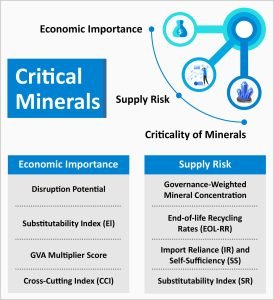22 Nov 2023 Tantalum
This article covers “Daily Current Affairs” and the topic details “ Tantalum”. This topic has relevance in the Science and Technology section of the UPSC CSE exam.
GS 3: Science and Technology
Why in the news?
In a groundbreaking revelation, a team of researchers from the Indian Institute of Technology (IIT), Ropar, has discovered the presence of tantalum, a rare metal, in the sands of the Sutlej River in Punjab. This discovery is poised to have far-reaching implications, particularly in the realms of electronics, semiconductors, and India’s strategic mineral policy.
Understanding Tantalum:
- Properties:
-
- Tantalum, with atomic number 73, is characterized by its grey color, heaviness, and exceptional corrosion resistance.
- Possessing high ductility, tantalum can be stretched into thin wires without breaking, and it boasts an extremely high melting point, surpassed only by tungsten and rhenium.
- Discovery:
- Discovered by Swedish chemist Anders Gustaf Ekenberg in 1802, tantalum was found in minerals obtained from Ytterby, Sweden.
Uses of Tantalum:
- Electronic Sector:
-
- Tantalum plays a pivotal role in the electronics sector, particularly in the manufacture of capacitors.
- Capacitors made from tantalum are known for their ability to store more electricity in smaller sizes, making them ideal for devices like smartphones, laptops, and digital cameras.
- Substitute for Platinum:
-
- Its high melting point positions tantalum as a cost-effective substitute for platinum in various applications.
- Medical Applications:
-
- Tantalum, due to its non-reactivity with bodily fluids, is employed in the production of surgical equipment and implants, including artificial joints.
- Industrial Uses:
-
- Tantalum carbide (TaC) in combination with graphite forms one of the hardest known materials, utilized on the cutting edges of high-speed machine tools.
- Widely used in components for chemical plants, nuclear power plants, aerospace, and missile systems.

Significance of Tantalum Discovery in Sutlej River:
- Semiconductor Manufacturing:
-
- The discovery holds particular significance for India’s semiconductor industry, aligning with recent governmental efforts to boost domestic manufacturing.
- Critical Mineral Policy:
- Tantalum is listed in India’s critical mineral policy, which addresses the country’s dependence on imports for 10 crucial minerals.
- This policy strategically maps mineral requirements for sectors such as renewables, defense, electronics, telecommunications, and transportation.
- Reducing Dependence on China:
-
- The discovery of tantalum in the Sutlej River is a step towards reducing India’s reliance on China for critical minerals.
- Renewable Energy Goals:
-
- Supports India’s ambitious renewable energy targets, aiming for a 500 GW share in the grid and a significant transition to electric vehicles by 2030.
- Economic Impact on State:
-
- The tantalum discovery has the potential to positively impact the state’s economy by promoting the mining of these valuable metals.
Source:https://indianexpress.com/article/explained/explained-sci-tech/tantalum-metal-sutlej-use-9036349/
Download Yojna daily current affairs eng med 22nd November 2023
Q.1 Regarding Tantalum, consider the following statements:
- Tantalum has atomic number 73.
- It is highly corrosion-resistant.
- Tantalum is crucial in the electronics sector, especially for capacitors known for efficient electricity storage.
How many of the above statement/s is/are correct?
(a) Only one
(b) Only two
(c) All three
(d) None
ANSWER: C
Q.2 Examine the importance of critical minerals for India’s strategic sectors. Discuss the challenges posed by their import dependency.


No Comments